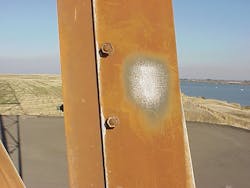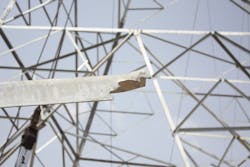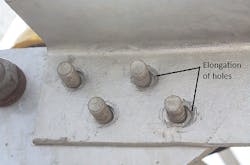Modernizing the Grid: Revisiting a Century of Transmission Structure Designs
Would you be surprised to learn that early lattice steel structures were not designed according to national standards? In the early days, each engineering firm followed its own unique design methodology, similar to how phone manufacturers once used different charging ports—until the USB-C emerged as universal standard. This lack of consistency resulted in structures built under varied criteria, creating significant challenges in their analysis that we continue to confront today.
The majority of the transmission infrastructure in the U.S. was built before 1960s and continues to support the electrical grid today. As electrical demand continues to rise, the grid must be modernized. This typically involves installing larger conductors or tightening conductor tensions to improve electrical clearances, leading to higher structural loads, sometimes exceeding the capacities the original structures were designed to handle.
The primary challenge in assessing aging structures is determining whether they still meet current code regulated strength requirements. Let’s explore the challenges of analyzing older transmission structures and summarize the various methods used for the analysis of these historical structures.
The Origins: Unique Design Approaches of the Past
To understand how these aging structures were originally built, it is important to look back at the design practices used over the last century. There are several approaches that are interesting and illustrate the progress made over the years. Beginning in the early 1900s there were no standards for designing lattice towers. During this time, the American Bridge Company was the leading provider of lattice towers and you might say they did it their way.
Several of their structures including tall river crossing towers are still in service. Their design approach is documented in their year 1925 publication “Transmission Towers” and is referenced for the study that will be discussed shortly. Materials science and engineering technologies continued to grow and advance.
By the 1960s, the practice of structural design had evolved and one approach was documented in the “Design Standards No. 10.” This publication came from the United States Department of the Interior, Bureau of Reclamation. It was one of the design methodologies used for design of lattice towers and hence is also referenced for this study, but structural design advancements did not stop there.
The American Society of Civil Engineers (ASCE) publishes standards for design of different structures. The publication of “Guide for Design of Steel Transmission Towers” in 1971, was the first attempt by ASCE towards formalized design standard. The majority of the design requirements we find in the current standard “Design of Latticed Steel Transmission Structures” (ASCE 10-15) have come from this 1971 publication. This ASCE 10-15 standard is used to represent the current design approach in this article.
Evolution of Design Practices and Standards
With the introduction of modern standards, discrepancies in capacity calculations started to emerge. The ability of an angle section to withstand tension forces, calculated using the current ASCE 10-15 standard is observed to be less than the capacity provided in the year 1925 ‘Transmission Towers’ publication. This is because ASCE 10-15 standard reduces the tension capacity of an angle connected on one leg by 10%. This was not the case in the historical structures. As a result, a historical structure when analyzed under current codes, may indicate that the member strength exceeds their design capacity.
Many historical structures often fail to meet connection rupture capacity requirements introduced by the ASCE 10 standard in the year 1990, since the older structures were not designed for this requirement. To comply with the current code, the structures will need to meet the current rupture capacity requirements.
Another key area where design methods have evolved significantly is in the calculation of compressive strength. Due to developments in research, the formulas for calculating compressive strength of structural members have evolved over the last century. When the compressive stresses for different unbraced lengths (slenderness ratios) obtained from the formulas from 1960s and those from early 1900s were compared with current standard, the results indicate that the current standard yields in higher member capacities. In the adjoining figure you can see that the leg members from the early 1900s were designed to only 79% of their maximum capacity.
Older transmission structures were designed using hand calculations, without the aid of calculators or computers. In contrast to today’s rigorous analysis, where hundreds of load combinations are considered, older structures were checked for only a few — usually just three load combinations. Despite being designed under less stringent criteria, many historical structures have endured over time, largely because their designs did not push the structures to their full capacity. These older structures also relied heavily on full-scale testing to verify their ability to withstand the design loads.
The compression formulas from ASCE 10-15 are designed for connections with a normal framing eccentricity. This means the bolt pattern's center should be between the angle's heel and the centerline of the connected leg. However, many historic structures don’t meet this criterion and have eccentric connections. For these cases additional analysis is needed to assess bending stresses typically outside typical tower analysis software.
Leveraging Technology in Structural Analysis
The challenges in the analysis of historical structures do not end with understanding the older design standards and codes. Another major challenge lies in the availability or accuracy of structural drawings. For older structures these records are often missing, incomplete, or difficult to interpret. When this happens, engineers rely on on-site inspections to gather necessary data, such as structure dimensions, member sizes, and the number of bolts. Modern technologies like drone photography and Light Detection and Ranging (LiDAR) make this process easier and safer.
LiDAR is particularly useful for capturing the overall dimensions of a tower. In some cases, it reveals differences between the existing structure and the original drawings. High-resolution drone images can also provide close-up views of complex connections or damaged areas without needing to physically climb the structure. Despite the advantages of these technologies, certain issues like connection failure from bolt bearing can only be identified through boots on the structure inspection.
The Evolution in Materials Science
The strength of bolts and steel has evolved with the development in material science. For example, the shear capacity of a 5/8” diameter bolt through the threaded portion increased from around 4 kips in the early 1900s to 15 kips today. However, in older structures, the grade and strength of steel members or bolts used may not always have been documented. In these situations, engineers can estimate the strength based on the era in which the structure was built. Alternatively, a member or bolt may be removed from the structure in question to test its strength in a laboratory. If a piece is proposed to be removed for testing, care should be taken by engineers to ensure that the tower remains stable without the member by utilizing specialized computer analysis and by replacing the missing parts on the structure.
Consider something like ASTM A394 grade bolts. They were introduced in 1955 specifically for transmission towers. These bolts had smaller heads and allowed for tighter connections. The next major change in bolt shear strength occurred when the 1984 version of A394 standard introduced four types of bolt grades (Type 0 and Type 1, 2, and 3).
The tensile capacity of these new bolts exceeds the tensile capacity of the member steel, and the bearing capacity of the bolt material does not govern in the design of connections. For older bolts, bearing of bolt material should be considered during analysis.
Several structural shapes used in historical structures have been discontinued. The historic member properties can be found in the AISC's historic member databases or can be calculated using a software program. When the custom section properties listed in the 1925 version of ‘Transmission Towers’ were compared with those derived from software calculations, the differences were negligible.
Physical Evaluation
In addition to the design and material properties, the physical condition of the structures after years of service is another critical factor. All the structural analyses assume that the structure is intact, and the structural capacity is same as the time it was first installed. While it is generally true, structure could deteriorate over the service life due to corrosion.
For old structures, corrosion is the most common issue leading to a reduction in its capacity. Corrosion reduces the cross-sectional area of the members and weakens its strength. If the tower members are damaged due to corrosion, the members need to be analyzed using the reduced cross-section area to account for the loss of material and strength. Corroded surfaces are bright red and have pitted surfaces.
However, members that appear to be corroded could have weathered galvanizing that is more of a reddish-brown staining. The reddish-brown staining is created when the iron in the zinc-iron alloy layers oxidizes.
Actual rust will only form if there is no zinc present where the defect is located. If only reddish-brown stains are present, the base steel is not rusted. When the member surface is sanded off, remaining galvanizing can be seen. It is important for an inspector of old structures to understand the differences between rust and weathered galvanizing and utilize best practices during analysis so that a structure’s capacity is not incorrectly reduced.
Given these shifts in design criteria and material standards, it’s no surprise that many historical structures might not meet all the requirements of the current code. While analyzing the old designs, it is important to understand the differences between the original design methodology and current standards before the structure’s existing capacity is determined. By combining lessons from the past with today’s engineering tools and technologies, we can ensure these structures continue to serve reliably while meeting the demands of modern infrastructure.





